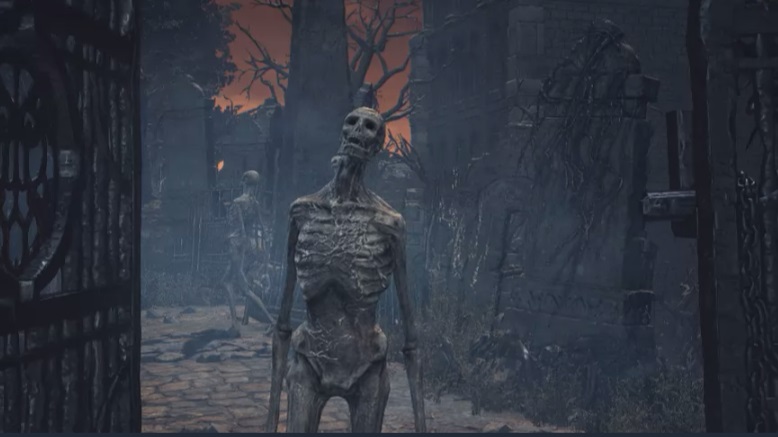How Dark Souls 3 builds up its most villainous slime lord
And uses the environment to tell a super sappy story

“But what do you really know about these Lords of Cinder, these supposed legends? Let's take Aldrich, for one: a right and proper cleric, only he developed a habit of devouring men. He ate so many that he bloated like a drowned pig then softened into sludge. So they stuck him in the Cathedral of the Deep and made him a Lord of Cinder; not for virtue, but for might.”
Hawkwood, the lowly defeated Undead Legionnaire that hangs his head low in Firelink Shrine, gives the player one of the first detailed descriptions of Aldrich, Saint of the Deep and unwilling Lord of Cinder. The dialogue triggers in a timely fashion, around the time you’re progressing through the swampy lands below the bridge to Lothric and towards the Cathedral of the Deep. The line’s light context is enough to color the state of the world you progress through, and in turn, the sludgy descent of Aldrich as a character—all without uttering another word. (Unless you count the tortured groans of the poor folks left in a Aldrich’s wake.)
Dark Souls 3 kicks off in pursuit of him—Aldrich bailed when called upon to link the fire. In other words, he’s meant to burn to prevent the apocalypse. Pay close attention and it’s easy enough to get the sense that he wasn’t exactly the saint his moniker ascribes—same goes for his affiliated religious institutions. It may not be possible to determine exactly who he is, but turning an open ear to the creatures and environments Aldrich has altered is enough to fill out his character in a few ways. I’m no lore aficionado, so look at this piece as a close reading of Dark Souls 3 and its power as a dense impressionist game—not as the final word on our slimey man.
Moby trick
The first aural indication to mark my descent was easy to miss at first, but now it stands as my favorite bit of atmosphere that reminded me where I was going and who I was after. Listen closely:
It’s a heavily forested area underscored by subtle, deep sea ambience. The white noise of wind through the trees dominates, lightly punctuated by the low hum of whales. There are plenty of connotations to unpack here: whales used to be viewed as creatures as old as the world itself, a sign of sentience and knowledge impossible for man to parse, and the ocean as a primitive bed of mystery and darkness, a place no human can naturally call home. Seeing that we’re headed to the Cathedral of the Deep, I’m starting to doubt that the ‘deep’ can be a good thing.
The oceanic sounds run opposite to what I’d expect to hear in a forest, and as my brain tries to conflate signs from two entirely different settings, I get uneasy, tense. Aldrich echoes the paradox: based on the opening cinematic, he resembles a massive glob of sea scum, algae you’d scrape off the underside of a boulder on the ocean floor. But he’s also supposedly sentient, a formerly respectable top dog in a local religious institution. I’m immediately set up to expect the impossible, but not necessarily anything too dark. Forest and ocean ambience suggest elegance (maybe a pre-goo slash cannibalism Aldrich) even though their combination is dissonant.
Narrative chunks
Deep in the forest, skinny cadavers lazily trudge around a cathedral graveyard where Aldrich was holed up. If I get too close and they discharge (not ceaselessly) a hefty amount of vomit, the ingredients of which look like maggots and milk, a brand of cereal I can’t quite get behind.
The biggest gaming news, reviews and hardware deals
Keep up to date with the most important stories and the best deals, as picked by the PC Gamer team.
Dozens of these enemies dot this area, and even though they’re easy to avoid, running past triggers puking for most of them, kicking off a cascade of vomitry that puts Mr. Creosote to shame. It’s more overtly gross than anything I can recall from the previous games, but still serves to characterize the gluttonous goo man we’re after. Every retch is an upsetting hybrid of a froggy croak and what sounds like a toilet flipping over, the exaggerated sound carrying connotations of overeating, sickness, and possibly trauma on a massive scale. I wonder if they died from this sickness and were buried in the cathedral graveyard in droves, or if the sickness is what caused them to rise from the dead. For there to be a graveyard in the open and not some guarded pit implies that this puking-slash-rising dead deal wasn’t always a problem, and perhaps Aldrich’s presence and transformation touched a certain dark magic—the deep—that ran wild and started to seep further out from the cathedral over time. Why should a church even need such a huge graveyard? What Aldrich did to cause such a sickness is uncertain, but our bellies are definitely meant to ache in gurgled harmony with the infected denizens affected by his presence.
Aldrich was a known hungry boy, so maybe these walking corpses are failed acolytes, like the rotten apple counterparts to the fresh grub men I run into next.
Wet and wild
It may sound like I was dancing around in ankle high water during this fight, but it took place on a stone surface inside a cathedral. Liquid sloshes around inside of the six or so maggot slug humans I’m fighting. Every hit is like taking a butcher knife to a pile of rotting watermelons. They emit vaguely human gargles as they die, and I emit vaguely human gargles in response. It’s unpleasant, in large thanks to the sound.
The resolute wetness echoes the earlier oceanic connotations. Looking like grubs is one thing, but because they move with such pronounced sloshy sounds, it’s suggested that these maggot men are fairly sumptuous and juicy, perhaps disillusioned members of Aldrich’s church that have a side gig in his snack drawer. I wouldn’t be surprised if that was the case. A religious institution might hold a lot of influence over its desperate clergy during the very real end times. Aldrich wanted to stay on top, to stay strong, so he turned the process of plumbing up and eating his bros into an honorary religious rite—even after he was gooified and scooped up and locked in his coffin. I get the impression his connection to dark magicks was strong enough to penetrate his prison and that he ran the place from the inside.
Rosaria, a vaguely woman-shaped pile of flesh and leader of the Fingers of Rosaria invasion covenant, seems to be head chef. The grub men hang out almost exclusively outside her chamber door, and upon completing a sidequest for her, she silently rewards you with a grub man of your own—to kill. Do the thing, and you’re rewarded with loot. There’s no doubt these juicy boys are disposable, and I wouldn’t be surprised if Aldrich ‘disposed’ of them regularly.
Hollow there
Eventually, I stumble into Aldrich’s coffin-chamber, where he’s supposed to be imprisoned until someone like myself rolls in, ready to reduce the guy to ash and prevent the apocalypse. I’m greeted by about two-dozen deacons with glowing red eyes, a boss fight foreshadowed by a prominent tableau located next to the first cathedral bonfire.
The deacons appear undead in the present, a hollowed remnant of their former selves and less capable of reason (a fairly obvious side effect of the undead curse), but what struck me about the tableau after revisiting it was that the deacons are depicted as undead in it as well. This implies that the church embraced the deep—eldritch (Aldrich) knowledge—from the get-go. The institutions set in place maybe have been constructed to build harmony around the mysticism of the deep’s power, but once Aldrich arrived and grew in strength, it’s clear from the devastation of the environments that all those plans have gone to shit. The deep’s on the loose.
This further solidifies my belief that Aldrich was never actually held against his will after his transformation into sludge, but continued to rule the church, amplify its connection with the deep (a dark abyssal realm, I imagine), and use the churchgoers as a steady resupply station for food and power until he was ready to take off in search of a larger powers and entities to consume. Aldrich wasn’t just begrudgingly hiding in wait until the Ashen One swung by to take him to Firelink Shrine, but was actually preparing to subvert the fire-linking process entirely by embracing the deep, the darker plane, and possibly becoming ruler of it altogether. He’s not just a pile of sludge; Aldrich is a desperate, egotistic, cruel man on the run. He’s one of the most obvious, influential, and nuanced villains in the Dark Souls series.
Exactly how he obtained that influence, who knows? Maybe he was cunning and charming, easy to trust. Perhaps he subsumed all these people and grown in size and power, literally a massive katamari of ooze tearing through the land. We could’ve just encountered Aldrich as a boss after reading a few small pieces of lore, but Dark Souls 3 dedicates entire zones to characterizing the liquid lord, and the environment is the primary tool with which we can build our strongest perception of Aldrich, even if that characterization isn’t definitive. The most engaging aspect of Dark Souls 3 (for me) are it’s questions, and the trust it places on the player to puzzle them out. There are no easy conclusions here, nothing set in stone, just a pile of imaginative building blocks, and we’re left in charge.
James is stuck in an endless loop, playing the Dark Souls games on repeat until Elden Ring and Silksong set him free. He's a truffle pig for indie horror and weird FPS games too, seeking out games that actively hurt to play. Otherwise he's wandering Austin, identifying mushrooms and doodling grackles.


